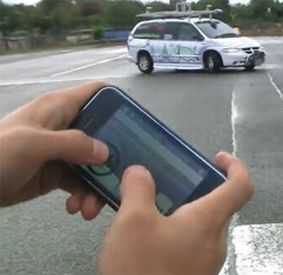 लोडिंग...
लोडिंग...
 लोडिंग...
लोडिंग...

Anyone who has ever fancied himself to be as suave and sophisticated as the famous British agent can start picking out number plates that end in ‘007’. We don’t want the female population to feel neglected, so Bond girl candidates can also start hunting for just the right outfit to go with their snazzy new wheels.
We’ve heard of everything, right from the much-maligned watch phones that we just love to hate, to the diamond-encrusted sparkly ones that we hate to love. However, we have never come across movie technology that has spilled over so invitingly into real life.
Enter the iPhone-controlled car.
The iPhone is a device that has captured many imaginations: its versatile charm is not restricted to a single continent, but spread across the world. It currently rests in the comfortable niche of being a benchmark that other phone manufacturers desperately attempt to meet. It is certainly not the best phone, but it was the most novel of its time. As a direct result of its immense popularity, people all over have taken their love for the iPhone and turned into something else.
Now almost everyone is a fan of German auto engineering – BMWs and Mercedes-Benzes send numerous hearts a-flutter. It is from that august automobile engineering nation that the first iPhone-driven car was born. The intelligent folks over at the Freie University in Berlin have rigged a small vehicle to transport it safely through the streets of Berlin without incident.
The pedals of the car have been jerry-rigged with mechanical devices, which the robotic scientists call a drive-by-wire system. There are video cameras mounted on the hood, and laser 3D sensors installed close by as well. The small station wagon is equipped with WiFi and GPS, making connectivity no issue at all.
On the iPhone, there is an application imaginatively called ‘iDriver’. The interface is shockingly simple, with a button for ‘Gas’, one for ‘Brake’ and a picture of a steering wheel with a big red cross cutting across it. Pressing one of the first two buttons activates the levers on the pedals in the vehicle. The steering wheel operates in a slightly different way: the driver presses and holds down the pressure on the virtual wheel, and twists the iPhone in the direction they want to go. The actual steering wheel mimics the movement perfectly, and the tyres are shown responding to the manipulation.
The commands are sent over WiFi, so the driver does not actually have to be in the vehicle to operate it. The background of the application is the video feed from the mounted cameras, akin to looking through the windscreen of the car.
All pleasantries apart, the iPhone app really does control the car effectively. Of course there is a tremendous amount of hardware that needs to be set up on the vehicle itself, but the astounding fact remains that it can be done. Perhaps future automobiles will have this functionality built into it from the get-go. Whatever happens, it is an exciting innovation to behold.